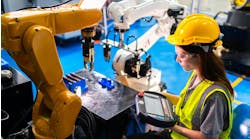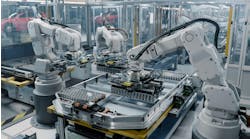This article is part of a series on how to prepare for the reign of robots through:
Programming languages are having a profound impact on robot integration in industrial machines. Robots are taking over the world. Some countries are so concerned with rapid robot expansion that there’s been discussion of a robot employment tax to countermand the displacement of workers caused by robot implementations. Chinese appliance maker, Midea, riding the momentum of its $4 billion acquisition of Kuka, intends to fend off Japanese competitors and dominate the world’s largest robot market.
There’s a lot at stake. With the rise and convergence of the Industrial Internet of Things and collaborative robot applications, the possibilities are endless. And a sure sign of the times was Schunk’s collaborative robot gripper, with embedded intelligence and two cameras, winning the Hermes Award at Hannover Messe 2017.
The sky’s the limit on robotic industrial applications. We asked a variety of industry experts some specific questions about where robots are headed and how they plan to get there.
Since almost every robot manufacturer utilizes a different programming language, is there a common denominator, such as Python, or a development platform that engineers should know as a foundation? And is there any chance of standardization in the near future?
Matthew Bush is COO and co-founder at Hirebotics.
In making a decision on software, automation integration companies may want to look at the history of the software vendor, as well as how the software has been developed to meet industry needs—user-friendly interface, complex simulation, infrastructure for Industry 4.0. The future development of software products is also important. Some companies want to offer a complete digital factory solution and have the resources to do so, while others may just stick with certain applications within automation, like CAD to Path only, for example.
There are some standards already in place, but the question is will they remain as automation evolves? The OPC-UA is a good example of that. This is a communication protocol that allows machine-to-machine communication for industrial automation. Software can communicate with a virtual robot and respond or react accordingly, so the simulation is 100% accurate.
Another thing to consider is what structural platform the programming software is based on. Is it some unique language that only a few people are experts in, or is it more common like C++? Is the software flexible enough that a development group can implement internal knowledge into the product? All important questions for companies that want to use simulation-based software for automation development.
Lee van Every is senior account manager at Cenit North America.
Henrik Jerregard is global product manager, robot controllers at ABB.
In the industrial space where programmable logic controllers (PLCs) have long reigned as the control king, robotic systems and languages have developed around these languages. Although there is some variation between manufacturers, the IEC 61131-3 programming standard, which includes sequential function chart (SFC), ladder diagram (LD) and continuous function chart (CFC), has been adopted by nearly every PLC manufacturer, and its acceptance is growing rapidly among machine builders. IEC 61131-3 is important to robotics as this standard has expanded to include motion control through PLCopen Motion Control and more recently to robotics through the PLCopen 4 substandard.
The benefits of a robotics standard, like the benefits of IEC 61131-3, are immense to the industry. Many robotics manufactures provide their own proprietary languages, making it difficult to integrate a robot into a machine that already has a PLC or PAC using IEC 61131-3. In this case, machine builders must learn a new proprietary language each time they implement a robotic system, requiring the programmer to start their education from scratch each time they use a new product, increasing the time to market. Using multiple devices and languages in a system increases the complexity of the machine, making maintenance and debugging difficult. With the adoption of the PLCopen 4 programming standard, all of this can be eliminated.
With PLCopen 4, robotics will be able to be directly controlled by the PLC or PAC, providing full-machine, central control. In addition, machine developers will be able to use a language that is consistent across different manufacturers. The ability to program robotics, motion control and PLC logic in a single device is a huge advantage, as programmers need to learn only one standard language and program one system.
The response is very different for lab automation and embedded controls. In this industry segment, instead of the PLC or PAC being the central control, generally the PC or another embedded device is the master, while the motion control or robotics is taken care of by another device. The preferred method of communicating to the motion controller is usually through some type of API in C#, C++, VBA, or Python, as you’ve mentioned. Usually the libraries that manufacturers provide to talk to their devices run the gamut of the most commonly used languages. The challenge is that the robotic and motion commands sent from the programmer’s application is still in a proprietary command language. These proprietary motion languages create a huge burden on both the programmer and future maintenance personnel. Although the industry does have players to the market such as ROS trying to create a standard, it is still far from experiencing widespread adoption. Although this industry could significantly benefit from standardization, it is unlikely to happen, as this space is usually an early adopter of new technologies fresh out of R&D without time for standardization.
Marissa Tucker is product marketing manager, controls and HMI at Parker Hannifin.
Brian Carlisle is CEO at Precise Automation.
Patrick Laughter is engineering manager, robotics, Denso Products & Services Americas.
Ryan Guthrie is executive vice president at TM Robotics.
Honestly, due to the competitive nature of robots, I do not expect to see a standard language or programming package in the future.
Daniel Moore is tech support manager at Universal Robots.
Mike Van Hoomissen is senior staff software engineer at DWFritz Automation.
From my experience, most of the modern programming languages—Python, C++, C#, Lisp, Java—are all beneficial to learn and master. As with any coding, more important than the language itself is the structure and intelligibility of the code itself. Learning any language will help in the long run; however, learning sound fundamentals and practices that will allow you to create efficient and understandable code will pay dividends in your career in robotics.
Maximiliano Falcone is senior manager, general industries engineering at Kawasaki Robotics USA.
Choosing an underlying program is not just about function, but also about processing speed; this affects the cycle time. To modify legacy systems that use .Net or C programs means greater expenses. Another expense that needs to be considered is the training of the service as well as maintenance staff.
Bhaskar Ramakrishnan is technical sales engineer at DWFritz Automation.
The reality is that companies deploying traditional automation will need expertise in a variety of programming languages in the short term. For collaborative robots, that roadblock has already been removed.
Jim Lawton is chief product and marketing officer at Rethink Robotics.
ALSO READ: How to get started with robotics
Mike Bacidore is the editor in chief for Control Design magazine. He is an award-winning columnist, earning a Gold Regional Award and a Silver National Award from the American Society of Business Publication Editors. Email him at [email protected].


















